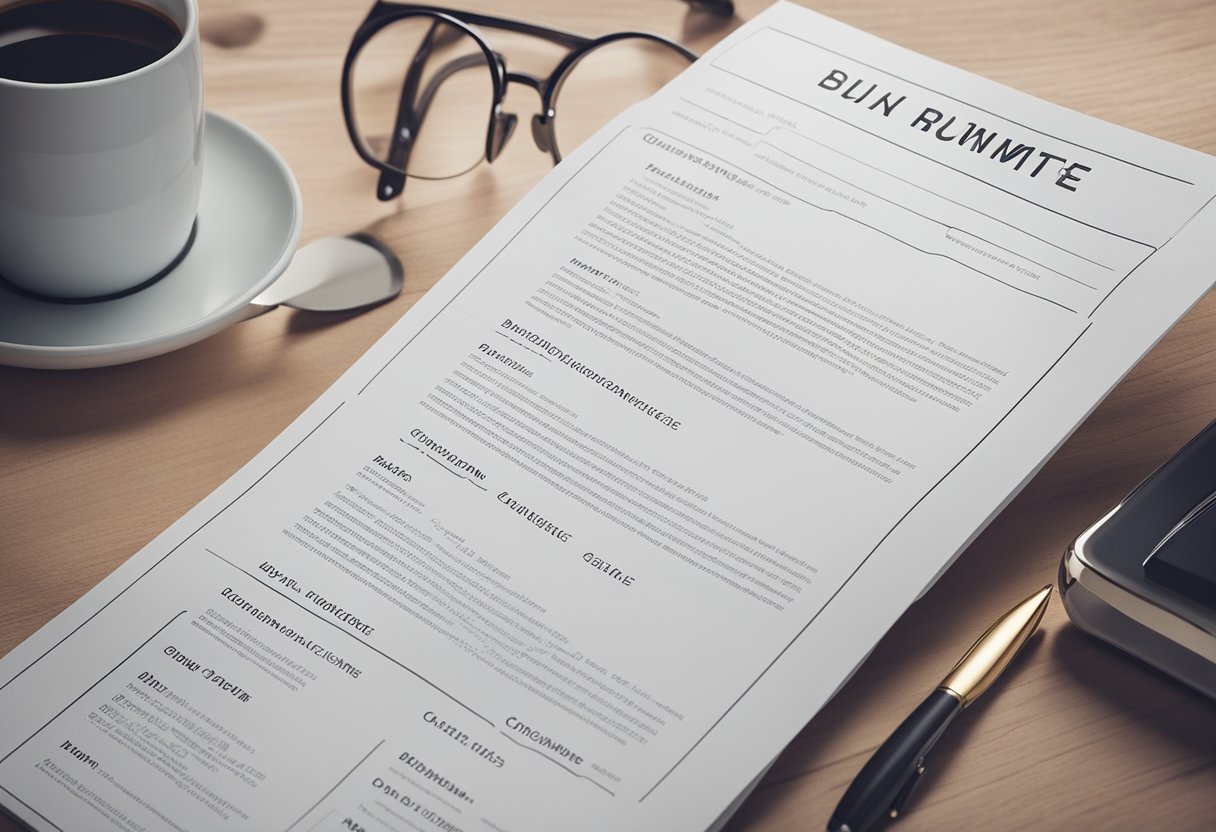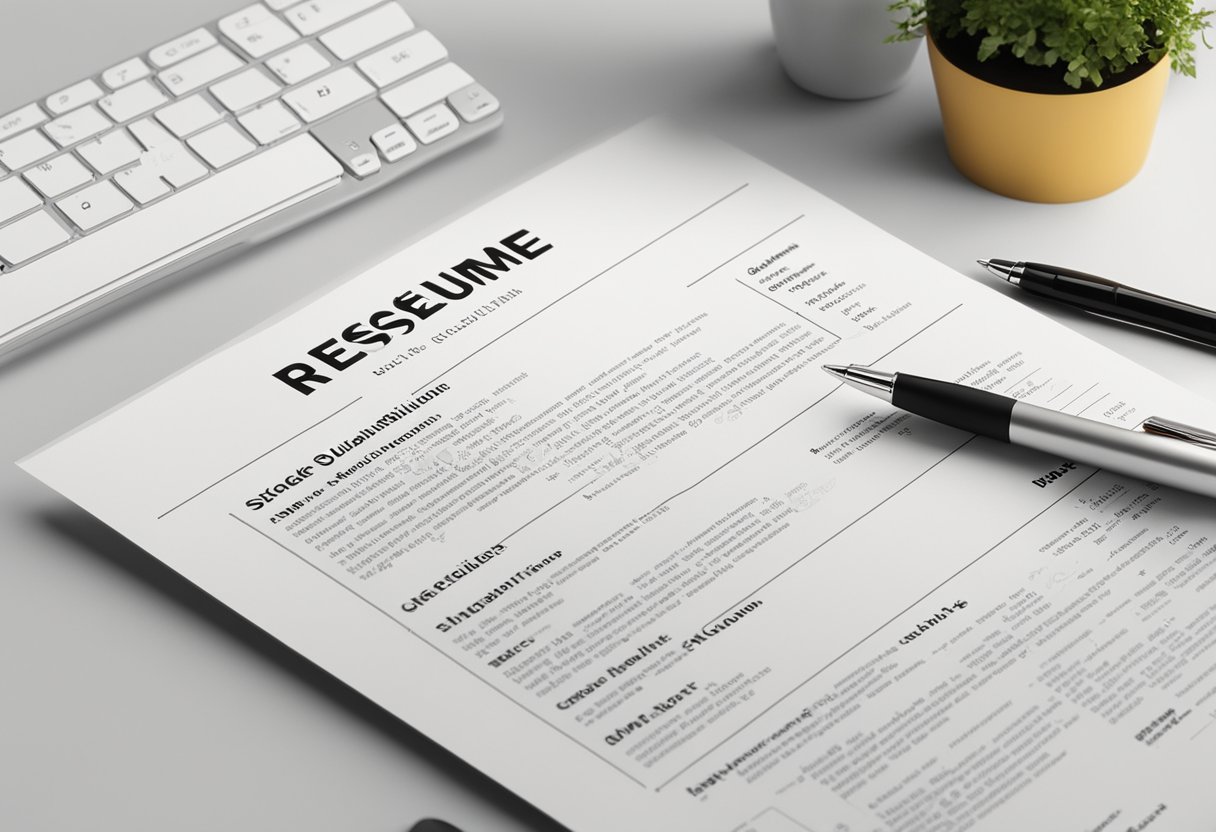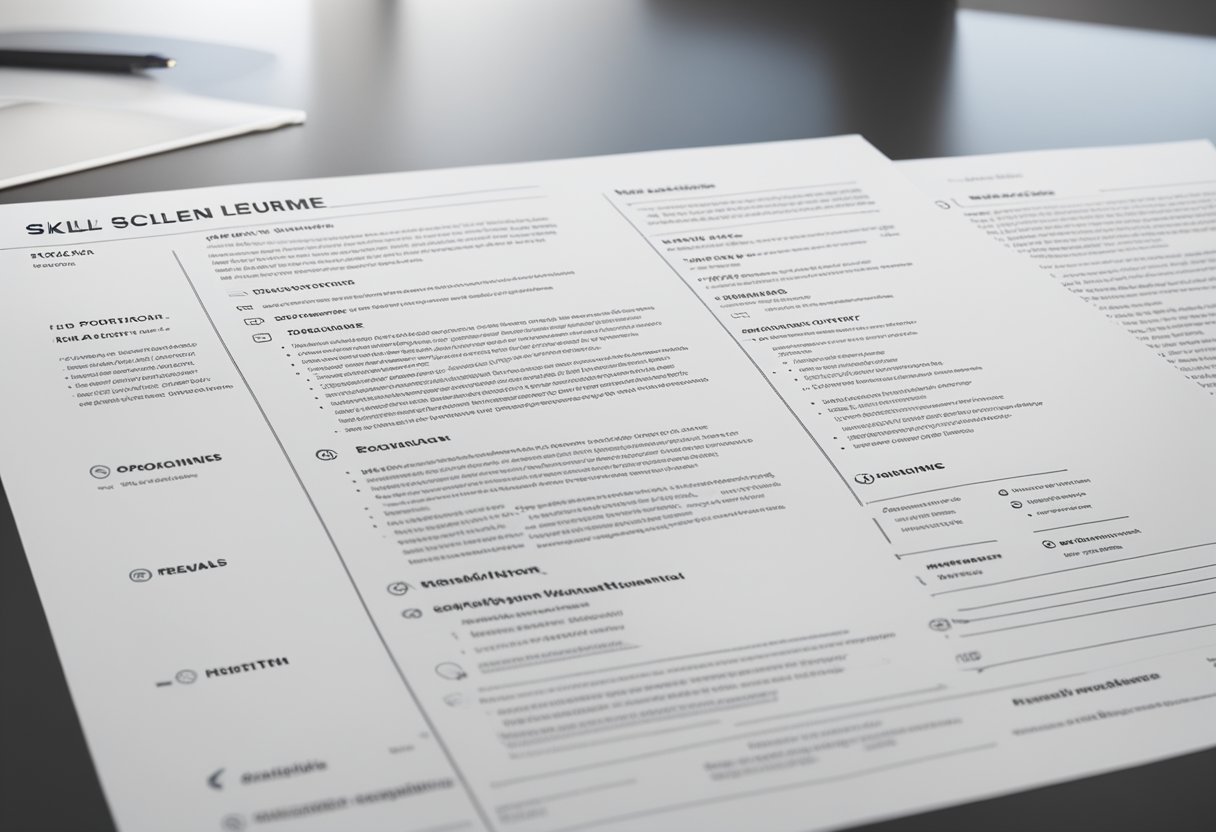How to List Skills in Your Resume Skills Section: A Guide to Enhancing Employability
Crafting a persuasive resume often hinges on the skills section, which showcases your abilities and expertise to potential employers. This paramount part of your resume conveys your professional qualifications and how they align with the job requirements. Accurately presenting your skills not only demonstrates your suitability for the role but also provides a quick reference for hiring managers scanning for essential competencies.

A thoughtfully assembled skills section aids in making a strong first impression. Including a range of both hard and soft skills tailored to the job description can set you apart from other candidates. Knowing how to strategically order and format these skills ensures they make an impact, enhancing your chances of securing an interview.
Key Takeaways
- An effective skills section is vital for presenting qualifications and competencies.
- Tailoring skills to the job description helps align with employer requirements.
- Proper ordering and format of skills enhance readability and impact.
Understanding the Resume Skills Section

A resume skills section is a crucial element of one's resume where the candidate showcases their abilities relevant to the job they are applying for. This section should be concise and tailored to the job description, emphasizing the skills that are most applicable.
To create a powerful skills section:
- Identify core competencies: one should start by listing their abilities, focusing on those most relevant to the job.
- Categorize skills as either hard or soft:
- Hard skills refer to technical knowledge or training you have gained through any life experience, including in your career or education.
- Soft skills are attributes and personality traits that affect interpersonal interactions.
The structuring of this section needs deliberation:
- Format: Present skills in a clear format, such as bullet points.
- Relevance: Align the skills with the job requirements.
- Evidence: Where possible, one should substantiate their skills with achievements or certifications.
For instance:
| Skill Type | Skills |
|---|---|
| Hard Skills | - Data Analysis |
| - Proficient in C++ | |
| Soft Skills | - Team Leadership |
| - Effective Communication |
They should include typically between three to ten skills to keep the section succinct; too few may sell themselves short, while too many might dilute the impact (How To List Skills On Your Resume Skills Section (With Examples)).
In a resume, the skills section is not just a list but a strategic part of the candidate's professional narrative. By carefully selecting and validating each listed skill, they can project themselves as the ideal candidate for the role.
Identifying Your Key Skills

Before crafting the skills section of a resume, a job seeker must first identify their key skills. They should reflect on both hard skills—the technical knowledge or abilities specific to a job—and soft skills, which are the personal traits and competencies that inform how one works.
One productive method to recognize these vital skills is to:
- Review the Job Description: Zero in on the skills that are frequently mentioned, especially those listed under the requirements or qualifications sections.
- Reflect on Past Experiences: Think about previous roles and pinpoint skills that led to successes and achievements.
Candidates might find it beneficial to divide their skills into relevant categories. For example:
- Technical Proficiency: Software knowledge, languages, certification-specific skills.
- Analytical Abilities: Problem-solving, research, critical thinking.
- Communication: Written and verbal skills, presentation ability, negotiation tact.
A well-maintained professional portfolio or a track record of past projects can be a valuable tool. This can help one recall instances where specific skills were applied effectively, providing concrete examples to mention during interviews or to highlight in the resume.
Brainstorming with Peers: Sometimes discussing with colleagues or mentors can uncover skills one might overlook. They can provide an outside perspective that can help a candidate realize the full range of their abilities.
Finally, merging the analyzed job requirements with one’s self-assessment leads to a refined list of key skills that are both authentic to the individual and tailored to the job they’re pursuing. Emphasizing these in the resume skills section can significantly strengthen a candidate's application.
Categorizing Your Skills
When crafting a resume, effectively categorizing your skills ensures potential employers can quickly understand a candidate’s capabilities. This layout aids in showcasing proficiency in different domains that align with job requirements.
Hard Skills
Hard skills are the technical knowledge or training that a person has acquired through any life experience, including in their career or education. These skills are job-specific and are typically listed in job postings and job descriptions. For example:
- Languages: Proficient in Spanish and French
- Software Proficiency: Advanced in Microsoft Excel, SAP, QuickBooks
Soft Skills
Soft Skills are interpersonal qualities or traits that affect one's ability to work and interact with others. They are less tangible and harder to quantify than hard skills. For instance:
- Communication: Exceptional listener and communicator who effectively conveys information verbally and in writing.
- Leadership: Respected leader, able to motivate team members to perform at their best.
Technical Skills
For those in industry-specific roles, Technical Skills involve specialized knowledge and expertise in fields such as IT, engineering, or finance. These may include:
- Programming Languages: Proficient in Java, C++, Python
- Operating Systems: Experienced with Linux, Windows, macOS
Tailoring Skills to the Job Description
Tailoring one's skills to a job description is a critical step in crafting an effective resume. A candidate should meticulously align their skills section with the requirements outlined in the position they are applying for.
Firstly, identify the necessary skills for the job by reviewing the job description. Often, a job listing will enumerate both required and desired talents that applicants should possess. Highlighting these skills on your resume ensures relevancy and demonstrates a tailored fit for the role.
Categorize your skills into two segments:
- Hard Skills: Specific, teachable abilities such as software proficiency, language fluency, or machine operation.
- Soft Skills: Interpersonal attributes like leadership, communication, or problem-solving.
Consider using a table format to clearly delineate skills:
| Hard Skills | Soft Skills |
|---|---|
| Software Mastery | Effective Leader |
| Data Analysis | Team Collaboration |
| Multilingual | Adaptive Thinker |
Employ a bullet-point list to present your skills within each category:
- Hard Skills:
- Software Mastery
- Data Analysis
- Multilingual
- Soft Skills:
- Effective Leader
- Team Collaboration
- Adaptive Thinker
Align your skills with quantifiable achievements when possible. Instead of merely stating a skill, illustrate it with an accomplishment from previous experience, which can offer tangible evidence of your capabilities. If the job description emphasizes a requirement, one should mirror this need in their resume skills section, linking it directly to professional triumphs.
Remember, customizing the skills section is about quality, not quantity. Focus on including skills that are most relevant to the job description, rather than attempting to list an exhaustive set of abilities.
Formatting Skills on Your Resume
When crafting a resume, the applicant must consider the most effective way to present their skills. The format should be clear and easily scannable for potential employers.
List Format
List Format organizes skills using bullet points, making them easy to read quickly. A job seeker might categorize skills into 'Technical' and 'Soft Skills', with bullet points under each.
Table Format
In a Table Format, the candidate divides skills into columns, such as 'Skill', 'Proficiency Level', and 'Years of Experience'. This structure provides a compact and quantifiable overview of capabilities.
Paragraph Format
Lastly, the Paragraph Format involves writing skills in a short, descriptive paragraph, often utilized when highlighting how each skill has been developed or applied in the applicant's career.
Prioritizing Relevant Skills
When crafting a resume, it's crucial for job seekers to identify the most pertinent skills related to the position they are applying for. Listing relevant skills not only demonstrates to potential employers that they possess the abilities necessary to excel in the job, but it can also give them an edge over other applicants.
To prioritize skills effectively:
- Assess the Job Description: Examine the job listing to find key skills that the employer emphasizes. These are the competencies they value the most.
- Match with Your Own Skills: Review your own skill set and highlight those that align with the job requirements.
- Industry Relevance: Consider the importance of your skills in the context of the industry and the position.
| Matched Skills | Industry Relevance |
|---|---|
| Technical proficiency | Highly Important |
| Leadership | Variable |
| Effective Communication | Critical |
Quantify Your Experience: Where possible, illustrate your abilities with quantifiable achievements, which may include metrics or specific milestones reached.
Categorize Your Skills: To maintain clarity, skills can be grouped into categories such as technical, managerial, and interpersonal.
- Technical Skills: Data analysis, software proficiency, technical writing
- Managerial Skills: Strategic planning, leadership, decision-making
- Interpersonal Skills: Communication, teamwork, problem-solving
Employers often scan resumes quickly, thus placing the most important skills near the top of the section can be advantageous.
By adhering to these strategies, candidates ensure they present themselves as the ideal match for the role, making it easy for employers to recognize their potential value to the organization.
Using Keywords Effectively
When crafting a resume, strategically embedding relevant keywords is crucial for catching the attention of hiring managers and passing the applicant tracking systems (ATS). One's choice of words can significantly impact their chances of landing an interview.
Firstly, candidates should identify industry-specific terms and job-related skills mentioned in the job posting. These keywords typically reflect essential qualifications and competencies, and integrating them can enhance the resume's relevance to the role.
Here's a succinct approach to keyword optimization:
Match the Job Description: Scan the vacancy notice for specific skills and qualifications required and ensure these terms are present in your resume.
Prioritize Hard Skills: Focus on tangible abilities such as foreign language proficiency or technical knowledge.
Use Variations: Incorporate synonyms and related phrases to cover different terminologies employers may use.
A small-scale demonstration of effectively using keywords might look like this:
| Job Posting Keywords | Resume Keywords |
|---|---|
| Proficient in Java | Java Expertise |
| Team Leadership | Leadership Skills |
| Budget Management | Managed Budgets |
Candidates are advised to be genuine in representing their skills. They should only list keywords that truly reflect their abilities and experiences. Exaggeration or misrepresentation can lead to complications later in the hiring process.
Incorporating keywords effectively is about balance and relevance. One should weave them throughout the skills section and entire resume where appropriate, ensuring the text remains human-readable and not just a list of buzzwords. Employers seek candidates whose resumes reflect a clear alignment with the job’s requirements, signaling that they may be well-suited for the position.
Incorporating Skills Throughout Your Resume
In a resume, the integration of skills should be strategic and contextual, enhancing each section with evidence of proficiency and relevance.
Professional Summary
The Professional Summary should present a concise amalgamation of a candidate's most significant skills. Here, one should highlight abilities in alignment with the targeted role, using powerful adjectives and industry keywords. For example:
- Highly adept at project management, with a keen ability to lead cross-functional teams and drive successful outcomes.
- Proficient in advanced data analysis and statistical modeling, underpinned by a strong foundation in mathematical theories.
Work Experience
Within the Work Experience section, it’s crucial to detail how specific skills were applied to achieve measurable results. Use bullet points to list key responsibilities and accomplishments, making sure to embolden critical skills that match the job description. For instance:
- Managed a team of 15 sales associates, increasing sales by 20% through strategic training and leadership skills.
- Designed and developed a new inventory tracking system, improving efficiency by 30% through advanced technical skills in software development.
Education Section
The Education Section can reflect foundational skills, especially for recent graduates with less work experience. It's appropriate to list relevant coursework, academic projects, and any societies or clubs where one exercised pertinent skills. Bullet points can effectively organize this information:
- Bachelor of Science in Computer Science | XYZ University, 2023
- Relevant Courses: Object-Oriented Programming, Database Management, Cybersecurity Fundamentals
- Academic Projects: Developed a secure e-commerce website as part of a team project, demonstrating strong coding and cybersecurity skills.
Demonstrating Proficiency Levels
When listing skills on a resume, it's critical to show employers at a glance your level of competency in those skills. Accurately demonstrating your proficiency levels can provide a clear picture of your capabilities and readiness for the job.
Basic Proficiency
At the Basic Proficiency level, an individual is familiar with the fundamental concepts or tools but might require additional guidance. They should list skills such as understanding of basic principles or familiarity with elementary functions. For example, in a programming language, they can write simple code snippets or understand syntax but cannot yet build complex applications.
Intermediate Expertise
Intermediate Expertise signifies a greater depth of understanding and autonomy. Individuals at this level can perform tasks with little to no assistance and have a more comprehensive knowledge of the skill. Skills at this level include the ability to troubleshoot common issues or conduct routine tasks efficiently. Someone with intermediate expertise in data analysis may be able to use statistical software to draw insights from datasets effectively.
Advanced Mastery
At the Advanced Mastery level, an individual not only has a deep understanding of the skill but also can innovate and solve complex problems. They should showcase abilities such as developing strategies or leading projects involving the skill. A person with advanced mastery in graphic design might create sophisticated designs and have a substantial portfolio of professional work.
Skills for Different Resume Types
When crafting a resume, it's crucial to tailor the skills section to the chosen resume format. Each type has a distinct way of presenting skills relevant to the job position.
Chronological Resume
In a Chronological Resume, the focus is on work history. Here, relevant skills should be highlighted in bullets under each job position, showcasing how they were applied to achieve results.
- Example:
- Managed a team of 10 (Leadership)
- Increased sales by 20% (Sales & Marketing)
Functional Resume
A Functional Resume emphasizes specific skills and abilities rather than a timeline of work history. Skills are categorized based on expertise and should be supported by accomplishments.
- Categories & Skills:
- Communication: Persuasive speaker, adept in presentations
- Technical: Proficient in HTML, CSS, JavaScript
Combination Resume
The Combination Resume merges elements from chronological and functional resumes. Skills appear both in a dedicated section listed with proficiency levels and are further elaborated in the experience section.
- Skills Section:
- Advanced: Project Management
- Intermediate: Graphic Design
- Experience Section Example:
- Lead designer for a major marketing campaign (Graphic Design)
Avoiding Common Mistakes
When crafting the skills section on a resume, one must be strategic to avoid common pitfalls that could undermine its effectiveness. Below are key mistakes to steer clear of:
- Generic Phrases: Job seekers often use overused terms like "hardworking" or "team player." Instead, one should focus on unique skills that offer a clear value to potential employers.
- Too Many Skills: Listing too many skills can overwhelm the reader. Aim for a concise list of 3-10 relevant skills.
- Poor Organization: Skills should be grouped sensibly, such as dividing them into hard and soft skills or categorizing them by relevance to the position.
Do:
- Align skills with job requirements.
- Quantify achievements where possible.
- Include a mix of both hard and soft skills.
Don't:
- Mention outdated or irrelevant skills.
- Overlook the proofreading of this section.
- Misrepresent your skill level; accuracy is key to building trust.
Lastly, it's essential that skills are not hidden within the job experience section but instead are clearly listed and easy to identify. This enhances readability and helps the employer quickly gauge the candidate's fit for the role.
Frequently Asked Questions
When crafting a resume, articulating skills in a clear and effective way is crucial for capturing the attention of potential employers. This section answers common queries about optimizing the skills section of a resume.
What are some effective ways to categorize skills on a resume?
Employers often look for both hard and soft skills, so one can group their skills into these two categories. Another approach is to separate technical skills from industry-specific skills, ensuring the resume matches the job description's requirements.
Which hard skills are most beneficial to include on a professional resume ?
The most beneficial hard skills to include are those that are specific to the job one is applying for. This often includes technical skills like proficiency in coding languages, software expertise, foreign language fluency, or machinery operation, depending on the industry.
How can fresh graduates effectively showcase their skills on a resume?
Graduates should focus on skills gained through education, internships, and volunteer experience. Project work, relevant coursework, and any hands-on experiences that relate to the job can be valuable inclusions that demonstrate applicable skills.
Can you give examples of how to phrase personal skills in a resume?
Personal skills, or soft skills, might be phrased as "excellent communicator," "strong leadership capabilities," or "proven problem-solving abilities". These should be backed up by brief examples of how they were applied in past experiences.
What key skills should be highlighted on a CV to enhance its impact?
To enhance the impact of a CV, an applicant should highlight key skills relevant to the role they are applying for. This may include skills like project management, data analysis, customer service, or any other competencies that align with the job description.
What approach should students take to list their skills on a resume?
Students can tailor their skills section to showcase their potential by listing transferable skills such as teamwork, time management, and adaptability. They should also include relevant academic projects, extracurricular activities, and any part-time work experience.

Get a higher quality resume format
Our Resume Builder ensures best practices, logic, formatting standards and job matching opportunities from thousands of job boards and portals around the world.
By clicking Start Your Resume, Your are agree to our Terms of use and Privacy Policy
 India's
premier resume service
India's
premier resume service






